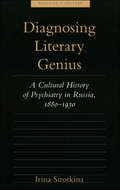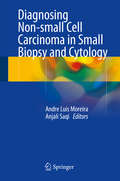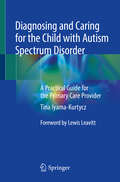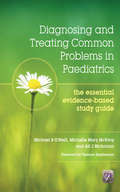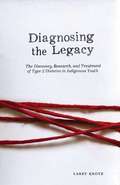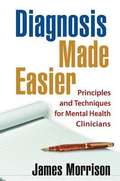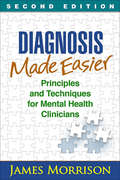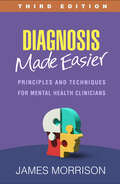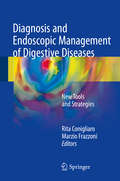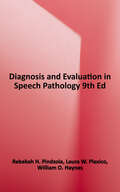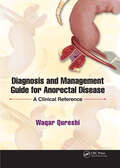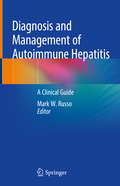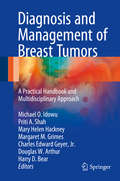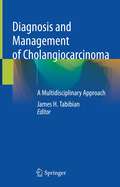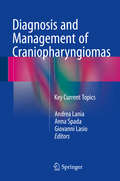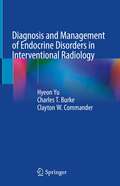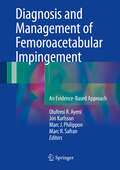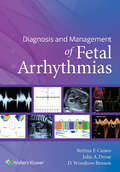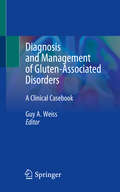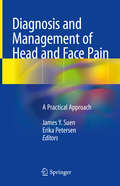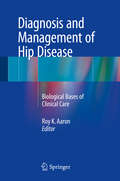- Table View
- List View
Diagnosing Literary Genius: A Cultural History of Psychiatry in Russia, 1880-1930 (Medicine and Culture)
by Irina SirotkinaWinner of the Aldo and Jeanne Scaglione Prize for Studies in Slavic Languages and Literatures from the Modern Language AssociationThe vital place of literature and the figure of the writer in Russian society and history have been extensively studied, but their role in the evolution of psychiatry is less well known. In Diagnosing Literary Genius: A Cultural History of Psychiatry in Russia, 1880-1930, Irina Sirotkina explores the transformations of Russian psychiatric practice through its relationship to literature. During this period, psychiatrists began to view literature as both an indicator of the nation's mental health and an integral part of its well-being. By aligning themselves with writers, psychiatrists argued that the aim of their science was not dissimilar to the literary project of exploring the human soul and reflecting on the psychological ailments of the age.Through the writing of pathographies (medical biographies), psychiatrists strengthened their social standing, debated political issues under the guise of literary criticism, and asserted moral as well as professional claims. By examining the psychiatric engagement with the works of Fyodor Dostoevsky, Nikolai Gogol, Leo Tolstoy, and the decadents and revolutionaries, Sirotkina provides a rich account of Russia's medical and literary history during this turbulent revolutionary period.
Diagnosing Non-small Cell Carcinoma in Small Biopsy and Cytology
by Andre Luis Moreira Anjali SaqiThis volume provides a practical yet comprehensive guide to manage the shift in the diagnosis of lung cancer from large resections to small samples, including cytology specimens and core biopsies. Specifically, it outlines various available minimally-invasive modalities and presents algorithms to optimize and maximize sample collection and processing beginning at the time of tissue acquisition during the procedure. Secondly, the book provides an overview of the various existing and emerging lung cancer therapies and why a specific diagnosis is crucial. Key elements for the classification of small biopsies and cytology proposed by the ATS, IASLC, and ERS are highlighted. A section dedicated to immunohistochemistry offers a logical, step-by-step guide to sub-classify lung cancers and to differentiate them from metastases. The text also provides a review of the various molecular tests (and alternatives in cases of scant tissue) required for lung adenocarcinomas. Finally, potential pitfalls to avoid during acquisition, processing, and classification are discussed. With contributions from a team of multidisciplinary authors who are regularly involved in the care of lung cancer patients , Diagnosing Non-small Cell Carcinoma in Small Biopsy and Cytology is an invaluable reference guide for pathologists, pathologists-in-training, and allied professionals, including oncologists, pulmonologists, surgeons, and radiologists.
Diagnosing and Caring for the Child with Autism Spectrum Disorder: A Practical Guide for the Primary Care Provider
by Tina Iyama-KurtyczThis unique resource is designed to be a practical, user-friendly guide for pediatricians, primary care providers, and all healthcare providers who work with children with autism spectrum disorder. Diagnosing and Caring for the Child with Autism Spectrum Disorder offers state-of-the art instruction to clinicians on how to recognize, diagnose and assist children with autism spectrum disorders, from early in life to transition to adulthood. This book will also delve into how to support pediatric patients by working with families, and discuss how to best interact with and support these families. The book opens with a comprehensive introduction of ASD and obstacles to diagnosis and common myths. Section Two is devoted to the early recognition of atypical development and reviews the steps in diagnosing autism, including the evaluation, the diagnostic visit, the developmental exam, and the discussion of findings with parents. Section Three covers treatment and interventions for the autism spectrum and includes a discussion on alternative therapies and how to direct parents toward evidence-based or plausible treatments. Section Four and Five addresses special topics that are relevant to the PCP’s or pediatrician’s long-term relationship with families, including chapters on anxiety, parents, challenging behaviors and common scenarios that occur across childhood for those who have ASD. Later chapters delve more deeply into providing informed, sensitive care for patients with intersecting identities, and discusses how gender identity and cultural perspective and attitudes can impact the pediatric patient with ASD. Engaging, and written in a conversational style, Diagnosing and Caring for the Child with Autism Spectrum Disorder will be an ideal resource for the pediatrician, primary care provider, and all healthcare providers working with children with ASD, providing concrete, step-by-step methods that readers can incorporate into their own practice.
Diagnosing and Treating Common Problems in Paediatrics: The Essential Evidence-Based Study Guide
by Michael Oneill Michelle Mary McEvoy Alf NicholsonThis remarkable new guide is the first hybrid text of its kind that adopts the traditional method of medical education and fuses it with an evidence-based approach. It covers, in great detail, all of the common conditions seen in primary and secondary paediatrics.<P><P> Skilfully designed for easy revision and reference, each chapter is devoted to a symptom, commencing with the objectives and essential relevant background material followed by history and examination. In the management section specific questions are posed and evidence based responses are offered, ensuring both patients and their parents are satisfied. Uniquely, in the majority of cases, evidence from randomized controlled trials is given.<P><P> To facilitate comprehension, revision and examination preparation, chapter includes a series of multiple choice questions and meticulous answers. It also includes an invaluable clinical slide and X-ray collection outlining key radiological features of many of the clinical conditions described to further aid understanding, recognition and diagnosis.<P><P> Diagnosing and Treating Common Problems in Paediatrics is a highly comprehensive primer of how to learn and evaluate knowledge and then translate that knowledge into practice. It provides paediatric consultants and students with the confidence, professionalism and unique communication skill required to work effectively with both children and parents, ensuring successful treatment and outcomes.
Diagnosing the Legacy: The Discovery, Research, and Treatment of Type 2 Diabetes in Indigenous Youth
by Larry Krotz Michael Moffatt Frances Desjarlais Heather Dean Jonathan McGavock Elizabeth SellersIn the late 1980s, pediatric endocrinologists at the Children’s Hospital in Winnipeg began to notice a new cohort appearing in their clinics for young people with diabetes. Indigenous youngsters from two First Nations in northern Manitoba and northwestern Ontario were showing up not with type 1 (or insulin-dependent diabetes), but with what looked like type 2 diabetes, until then a condition that was restricted to people much older. Investigation led the doctors to learn that something similar had become a medical issue among young people of the Pima Indian Nation in Arizona though, to their knowledge, nobody else. But these youth were just the tip of the iceberg. Over the next few decades more children would confront what was turning into not only a medical but also a social and community challenge. "Diagnosing the Legacy" is the story of communities, researchers, and doctors who faced—and continue to face—something never seen before: type 2 diabetes in younger and younger people. Through dozens of interviews, Krotz shows the impact of the disease on the lives of individuals and families as well as the challenges caregivers faced diagnosing and then responding to the complex and perplexing disease, especially in communities far removed from the medical personnel a facilities available in the city.
Diagnosing the Less Common Skin Tumors: Clinical Appearance and Dermoscopy Correlation
by Caterina LongoCaterina Longo, MD, PhDAssociate Professor, Dermatology and Venereology, at Università degli Studi di Modena e Reggio Emilia (UNIMO); Azienda Unità Sanitaria Locale – IRCCS di Reggio Emilia, Centro Oncologico ad Alta Tecnologia Diagnostica, Modena, Italy; President of AIDNID; Executive Board Member of the International Dermoscopy Society Many texts deal with how to diagnose the straightforward melanomas of the skin, but there are many less common skin tumors that a clinician needs to be aware of because these are still likely to be encountered at some point in a clinical setting and many of them have serious implications. This highly illustrated text from an internationally acclaimed researcher provides a reliable guide to how to proceed with diagnosis of these more challenging entities. Contents: Tumors of the Epidermis: Nevoid basal cell carcinoma syndrome * Fibroepithelioma of Pinkus * Basosquamous carcinoma * Verrucous carcinoma * Sarcomatoid squamous cell carcinoma * Lentigines, Nevi, and Melanoma: Atypical Spitz nevus (tumor) * Halo Spitz nevus * Desmoplastic nevus * Pigmented epithelioid melanocytoma * Animal-type melanoma * Nevoid melanoma * Balloon cell melanoma * Desmoplastic melanoma * Special site melanoma (mucosal, acral) * Tumors of Cutaneous Appendages: Trichoadenoma * Trichoepithelioma and Brooke-Spiegler syndrome * Desmoplastic trichoepithelioma * Trichoblastoma * Tumors of the follicular infundibulum * Tricholemmoma and tricholemmal carcinoma and Cowden syndrome * Pilomatrixoma * Fibrofolliculoma/trichodiscoma and Birt—Hogg-Dubè syndrome * Sebaceous tumors *Syringocystadenoma papilliferum * Hidradenoma * Cylindroma and familial cylindromatosis and Brooke-Spiegler syndrome * Spiradenoma * Mammary and extramammary Paget’s disease * Syringoma * Eccrine poroma and eccrine porocarcinoma * Mesenchymal Tumors: Dermatofibrosarcoma protuberans * Atypical fibroxanthoma * Malignant fibrous histiocytoma (pleomorphic undifferentiated sarcoma) * Other Uncommon Tumors: Merkel cell carcinoma * Kaposi’s sarcoma * Angiosarcoma * Retiform hemangioendothelioma With contributions from: Alessandro Annetta * Giuseppe Argenziano * Elisa Benati * Caterina Bombonato * Stefania Borsari * Eugenia Veronica Di Brizzi * , Gerardo Ferrara * Giorgio La Viola * Mara Lombardi * Elvira Moscarella * Riccardo Pampena * Giovanni Paolino * Simonetta Piana
Diagnosis And Control Of Johne's Disease
by Committee on Diagnosis Control of Johne's DiseaseJohne's Disease is a chronic, progressive intestinal disease caused by infection with Mycobacterium avium subspecies paratuberculosis (Map) that affects primarily ruminant animals. In recent decades there has been growing concern over the lack of effective control of this disease and questions have arisen regarding the possibility that Map infection could be a cause of some cases of Crohn's disease in humans. This report presents a broad outline of the steps that should be taken to control Johne's disease, reduce the spread of Map, and minimize effects of the disease in animals. The report also describes the weaknesses of our current research agenda and provides recommendations for a new research strategy to resolve the question of whether there is a link between Johne's and Crohn's diseases.
Diagnosis Made Easier
by James Morrison Richard BalonThis authoritative, user-friendly book offers a complete introduction to the art and science of mental health diagnosis. Meeting a key need for students and novice clinicians, James Morrison, the author of the bestselling DSM-IV Made Easy, systematically takes the reader through every step of the process. He provides clear-cut principles and decision trees for evaluating information from a variety of sources and for constructing a valid working diagnosis that serves as a foundation for treatment. Special features include quick-reference tables, sidebars explaining key concepts, and over 100 case examples that bring the approach to life.
Diagnosis Made Easier, Second Edition: Principles and Techniques for Mental Health Clinicians
by James MorrisonThis popular practitioner guide and course text takes the reader step by step through diagnostic decision making in mental health. Acclaimed for both the clarity of his writing and his clinical expertise, James Morrison provides principles and decision trees for evaluating information from multiple sources and constructing a valid, clinically useful working diagnosis. More than 100 vivid vignettes--from the straightforward to the toughest cases--illustrate the practical application of these methods. Essential topics include developing a differential diagnosis, dealing with comorbidity; and determining when physical illness may be the cause of mental health symptoms. New to This Edition *Revised throughout for DSM-5. *Updated resources and suggested readings.
Diagnosis Made Easier: Principles and Techniques for Mental Health Clinicians
by James MorrisonThe third edition of this incisive practitioner resource and course text--updated for the DSM-5 Text Revision (DSM-5-TR)--takes the reader step by step through diagnostic decision making in mental health. Guidelines are presented for evaluating information from multiple sources, constructing a wide-ranging differential diagnosis, creating a safety hierarchy, and using decision trees to derive a valid working diagnosis. The book addresses specific issues in diagnosing the conditions most often seen in mental health practice, with an emphasis on how diagnosis informs effective treatment. More than 100 vivid vignettes illustrate the diagnostic process and allow readers to practice their skills. New to This Edition *Revised throughout for DSM-5-TR, including the new diagnosis of prolonged grief disorder. *Chapter on eating and sleeping disorders, including new decision trees. *New and updated vignettes and suggested readings.
Diagnosis and Endoscopic Management of Digestive Diseases
by Rita Conigliaro Marzio FrazzoniIn this book, leading international experts describe and discuss the various techniques available for the screening, diagnosis, management, and follow-up of digestive diseases, providing clinically useful, up-to-date reviews that draw upon their own experience and focus attention on the most recent advances in the field. Among the wide range of topics covered are the use of confocal laser endomicroscopy in the gastrointestinal tract, endoscopic suture systems, endoscopic submucosal dissection, per oral endoscopic myotomy, and cholangioscopy systems. The experience of a leading surgical group in the application of endoscopic radiofrequency ablation in pancreatic cancer is reported, and new surgical and endoscopic techniques for the treatment of Zenker's diverticulum are proposed. The closing chapters examine the present and future of esophageal motility testing and the diagnostic yield of novel parameters in reflux monitoring. In addition to the discussion of techniques, advice is provided on training, endoscopy and imaging equipment, and set-up of endoscopy units during procedures.
Diagnosis and Evaluation in Speech Pathology , Ninth Edition
by William O. Haynes Rebekah H. Pindzola Laura W. PlexicoDiagnosis and Evaluation in Speech Pathology presents practical, useful assessment issues and tips on specific speech-language-swallowing disorders; provides flexible ways to assess the disorders through both standardized and non-standardized appraisal; and guides readers’ attention through a wide variety of learning tools, including new assessment materials available commercially through research publications and via social media, learning objectives and self-assessment questions for each chapter, and concluding remarks that wrap up the information covered. The material also aids the clinician with accountability to third-party payors. The new Ninth Edition of Diagnosis and Evaluation in Speech Pathology has been updated throughout and includes a new chapter on adult dysphagia and pediatric feeding and swallowing disorders; a new chapter on issues of head and neck cancer and laryngeal speech rehabilitation; a revised chapter on report writing; current clinical insights into diagnosing and evaluating communications disorders, and two new Appendices, one showing how to conduct oral peripheral examinations and the other presenting standard reading passages, which can be used in various types of assessment.
Diagnosis and Management of Complications of Peritoneal Dialysis related Peritonitis
by Georgi Abraham Santosh Varughese Uma SekarThis book is unique in addressing the management and complications of PD-related peritonitis to reduce morbidity and mortality. It addresses the measures to prevent peritonitis, types of tools used for diagnosis, including molecular techniques, the focus of microbiologists for educating peers, catheter-related issues such as catheter care, exit site, and tunnel infection, catheter removal, reimplantation techniques, nurses' role, nutrition aspects, surgical methods and pediatric peritoneal dialysis, peritonitis with its uniqueness in detail. Each chapter starts with a case scenario and pictures related to the branch by the contributors' experience.This book is helpful for physicians, nurses, technicians, microbiologists, ID trainees and consultants, nephrology trainees, nephrologists, and surgeons involved in PD care.
Diagnosis and Management Guide for Anorectal Disease: A Clinical Reference
by Waqar QureshiMany gastroenterologists are presented with patients complaining of one or more of several anorectal symptoms. Patients expect that a gastroenterologist can treat their symptomatic hemorrhoids or anal fissures or diagnose accurately their rectal bleeding. Today the evaluation and treatment of these common ailments is not included within the core curriculum of most gastrointestinal fellowship training programs, and therefore has not been incorporated into a typical GI practice. Diagnosis and Management Guide for Anorectal Disease: A Clinical Reference looks to fill that void. Dr. Waqar Ahmed Qureshi states that most of these perianal and anorectal problems can be successfully treated non-surgically. Diagnosis and Management Guide for Anorectal Disease: A Clinical Reference reviews a number of diseases that gastroenterologists should be able to effectively manage in their office, which eliminates extra cost, inconvenience, and frustration for their patients.A few of the topics that can be found inside: Anatomy and Examination Anatomy and Physiology of the Pelvic Floor Benign Anorectal Conditions Hemorrhoids, Anal Fissures, and Anal Pruritus Benign Soft Tissue, Perianal, Perineal, and Complicated Conditions Pilonidal Disease, Aanorectal IBD Management, and Defecation Disorders Neoplasms Anal Carcinoma and screening high-risk groups The gastroenterologist occupies a unique position between conservative treatment offered by primary care physicians and the more invasive procedures offered by the surgeon. Diagnosis and Management Guide for Anorectal Disease: A Clinical Reference is designed to provide a comprehensive understanding of anorectal diseases that they can manage and, therefore, improve the care of their patients in one comprehensive volume.
Diagnosis and Management of Autoimmune Hepatitis: A Clinical Guide
by Mark W. RussoThis text provides a concise yet comprehensive overview of autoimmune hepatitis (AIH). The book reviews diagnosis criteria for AIH, biochemical and histologic findings in typical and atypical cases, and treatment with first, second, and third line therapies. Furthermore, the book discusses management of AIH for specific patient populations, including pediatric patients, pregnant patients, and patients undergoing liver transplantation. Criteria for stopping therapy and risk of relapse, studies demonstrating the efficacy and safety of alternatives to corticosteroids, and diagnosis and treatment of overlap syndromes are also explored in the text.Written by experts in the field, Diagnosis and Treatment of Autoimmune Hepatitis: A Clinical Guide is a state-of-the-art resource for clinicians and practitioners who treat and manage patients with AIH
Diagnosis and Management of Breast Tumors
by Jr. Michael Ola Idowu Priti Anilkumar Shah Mary Helen Hackney Margaret Mary Grimes Charles Edward Geyer Douglas William Arthur Harry Douglas BearThis text is designed to present a practical and concise handbook on the diagnosis and management of breast diseases for quick reference by trainees and practitioners. It emphasizes the approach to diagnosis and management of breast tumors written from the perspectives of each member of the multidisciplinary management team (pathologist, radiologist, medical oncologist, surgical oncologist and radiation oncologist). The text is divided into two sections. The first section is written by each subspecialty with focus on the overview and management of breast tumors, current controversies, position statement when necessary, and quality assurance. The radiology overview addresses questions such as when to perform breast imaging, the difference between screening and diagnostic mammograms, when to perform Magnetic Resonance Imaging (MRI) and ultrasound, the meaning of radiological descriptors, and lastly the cost effectiveness and quality assurance of radiologic assessment of breast tumors. The pathology overview addresses approaches to evaluation of breast biopsies and excision for calcifications, densities, distortion, asymmetry and masses, pitfalls to histologic interpretations, the utility of immunohistochemical stains, quality assurance and cost effectiveness, and current controversies and position statements. Surgical, medical and radiation oncology overviews address when to treat and when to refrain, current treatment options or modalities and the factors informing choice, utility of genomics or molecular diagnostics in management, quality assurance, controversies and position statements. The second section discusses common breast tumors (focusing on radiologic-pathologic diagnosis and correlation) using the practical approach highlighted in the first section. The entities discussed include but are not limited to fibroepithelial tumors, papillary lesions, spindle cell lesions, in-situ and invasive carcinomas. The uniqueness of this book is the focus on the integrated subspecialty approaches with perspectives directly from subspecialty experts and emphasis on how each member of the multidisciplinary team can contribute to the optimal care of the breast cancer patient. The text aims to bridge the gap of the "what next" question and foster a comprehensive, team approach for trainees and practicing physicians by providing information about specific entities from diagnosis to treatment. Generous illustrations and tables in the text enhance appreciation of the entities being discussed.
Diagnosis and Management of Cholangiocarcinoma: A Multidisciplinary Approach
by James H. TabibianThis book provides a comprehensive, state-of-the-art overview of cholangiocarcinoma (CCA). The text is structured to effectively present a broad yet concise overview of bile duct cancer, its relevant definitions, classification schemata, clinical management tenets, translational (including molecular and cellular) facets, and future directions. The book features numerous high-yield illustrations and is authored by an eclectic range of renowned experts in various areas of CCA, reflecting the multidisciplinary nature of the field.Filling a critical gap in the field, Diagnosis and Management of Cholangiocarcinoma: A Multidisciplinary Approach is a valuable resource for clinicians and practitioners who treat patients with bile duct cancer.
Diagnosis and Management of Craniopharyngiomas
by Andrea Lania Anna Spada Giovanni LasioThis book provides up-to-date coverage of the most relevant topics in the diagnosis and management of craniopharyngiomas. After introductory discussion of natural history and clinical presentation, individual chapters are devoted to pathological and molecular aspects, use of diagnostic imaging techniques, the surgical approach to craniopharyngiomas, radiotherapy and radiosurgery, and associated endocrine disturbances. A particular feature of the book is the detailed attention devoted to the metabolic consequences of the disease and related treatments, including obesity and electrolyte disturbances, and to cognitive alterations. This book will be of value to oncologists, neurosurgeons, and endocrinologists by assisting in diagnostic workup, delivery of appropriate treatment, and management of the serious metabolic and endocrine consequences.
Diagnosis and Management of Endocrine Disorders in Interventional Radiology
by Clayton W. Commander Hyeon Yu Charles T. BurkeThis book provides a comprehensive guide for selective venous sampling procedures and the role of interventional radiologists in the care and treatment of patients with endocrine disorders. Disorders of the endocrine system involve an imbalance in the natural homeostasis of the hormones produced by the glands in the body. There are a variety of endocrine conditions that are characterized by either hormonal hyposecretion or hypersecretion. Percutaneous selective venous sampling is the gold standard diagnostic tool for the medical and surgical management of patients with a variety of such disorders. Selective venous sampling is a minimally invasive interventional procedure that interventional radiologists perform to localize sites of abnormal hormone secretion. Computed tomography and magnetic resonance imaging are the most used diagnostic imaging modalities in patients with the suspected endocrine disorder; however, their specificity is not optimal, and identifying a culprit gland is difficult based on imaging findings alone. Therefore, the ultimate decision for management depends on the outcome of selective venous sampling. As these various venous samplings are increasingly performed worldwide, the collaboration between interventional radiology, endocrinology, surgical endocrinology, surgical oncology, neurosurgery, and gynecology teams is essential. With limited literature on the topic, this volume fills the gap with in-depth coverage of selective venous sampling alongside the pathophysiology, epidemiology, clinical diagnosis, as well as medical, surgical, and interventional management of endocrine disorders. The book is divided into five parts: Clinical, Laboratory, and Radiological Diagnosis of Endocrine Disorders; Selective Venous Sampling in Interventional Radiology; Medical Treatment of Endocrine Disorders; Surgical Treatment of Endocrine Disorders; Interventional Treatment of Endocrine Disorders. Throughout these parts, endocrine disorders that require venous sampling are covered in depth: primary aldosteronism, primary hyperparathyroidism, Cushing’s disease, hormone-secreting pancreatic adenomas, and androgen-secreting ovarian tumors. There is additionally an emerging role for interventional management in thyroid gland disorders, which is covered here. This is an ideal guide for interventional radiologists caring for patients with endocrine disorders, as well as endocrinologists, endocrine surgeons, surgical oncologists, otolaryngologists, neurosurgeons, gynecologists, and nephrologists.
Diagnosis and Management of Femoroacetabular Impingement
by Marc R. Safran Olufemi R. Ayeni Jón Karlsson Marc J PhilipponThis book is unique in combining an exclusive focus on femoroacetabular impingement (FAI) with an evidence-based approach and the involvement of a diverse group of global experts. It is designed to meet the worldwide need for a summary of current evidence that will readily assist the physician in establishing the most accurate diagnosis and providing the best available treatment. The coverage is wide ranging, encompassing clinical examination, differential diagnosis, imaging, indications for surgery, contemporary arthroscopic and open management, treatment of labial tears, cartilage injury management, non-operative management, rehabilitation, treatment of complications, and revision surgery. Trainees, physicians, surgeons, and allied health care professionals who treat young adults with hip pain will find the book to be an excellent source of information on what procedures are most helpful and how they should be implemented.
Diagnosis and Management of Fetal Arrhythmias
by D. Woodrow Benson Bettina Cuneo Julia DroseAccurate diagnosis of fetal arrhythmias is a challenging and essential skill for obstetric practitioners. Diagnosis and Management of Fetal Arrhythmias is the first and only text devoted exclusively to these difficult-to-diagnose abnormalities, helping you distinguish similar rhythms and provide appropriate patient care. Abundant illustrations and dozens of videos online provide clear visual guidance for ultrasound diagnosis of fetal cardiac rhythms.
Diagnosis and Management of Gluten-Associated Disorders: A Clinical Casebook
by Guy A. WeissThis clinical casebook provides a comprehensive yet concise state-of-the-art review of gluten-associated disorders. Presented in a case-based format, the casebook reviews the overall management of celiac disease (from seronegative through classical to refractory disease) as well as non-celiac gluten/wheat sensitivity, with an emphasis on gastrointestinal and extra-intestinal manifestations of these disorders. Specific topics presented in these cases include, for instance, dermatitis herpetiformis, celiac disease and the liver, non-responsive celiac disease, celiac crisis, overlap with functional gastrointestinal disorders, and fructan intolerance. Two chapters written by expert dieticians share their experience in managing celiac disease and gluten/wheat sensitivity. Written by international experts in the field, Diagnosis and Management of Gluten-Associated Disorders: A Clinical Casebook is a valuable resource for both adult and pediatric gastroenterologists, hepatologists, primary care physicians, dermatologists, registered dieticians, trainees, and researchers interested in gluten-associated disorders.
Diagnosis and Management of Head and Face Pain: A Practical Approach
by James Y. Suen Erika PetersenThis text is a comprehensive guide to the evaluation of patients with head and face pain. It is a resource for any physician or dentist to properly diagnosis and to learn the options for treating head and face pain, as well as know when to refer a patient to a specialist and how to identify which specialist is needed. It discusses the basic anatomy, etiology, and pathophysiology of head and face pain, classification guidelines for treatment, and clinical case examples. Additional chapters on nerve blocks, nerve stimulators, radiosurgery, microvascular decompression, Botox, and alternative and complementary medicine are also included. Diagnosis and Management of Head and Face Pain will be an invaluable resource for otolaryngologists, family physicians, oral surgeons, dentists, neurologists, neurosurgeons, pain specialists, and patients who suffer from head and face pain.
Diagnosis and Management of Hepatic Encephalopathy: A Case-based Guide
by Jasmohan S. BajajThis volume provides a comprehensive, state-of-the-art overview of hepatic encephalopathy. Through a case-based approach, the text reviews new data and studies about the role of microbiota in liver disease and hepatic encephalopathy, explores the burden of hepatic encephalopathy on readmissions, costs, and patient care, and highlights management strategies for patients in differing stages of hepatic encephalopathy. Exploratory new therapies and treatment targets are also discussed in the guide.Written by experts in the field, Diagnosis and Management of Hepatic Encephalopathy: A Case-based Guide is a valuable resource for physicians and researchers who deal with this challenging complication of cirrhosis.
Diagnosis and Management of Hip Disease
by Roy K. AaronPresenting recent advances in clinical diagnosis and treatment derived from an increased understanding of the biology of the hip, this unique text examines hip disease and pathophysiology through the lenses of kinematics, biomechanics, anatomy and metabolism. Opening chapters examine the impact of health care organization on hip care and prevalence and burden of osteoarthritis. Biomechanical considerations of the hip and gait pathomechanics in hip disease are then discussed, followed by chapters covering femoroacetabular impingement, possible links between OA and metabolic syndrome, osteonecrosis, osteoporosis and Paget's disease. Considerations of risk reduction surrounding hip arthroplasty conclude the text, including device and surgical options for THA, hip sepsis and prevention of perioperative infection, and management of venous thromboembolism. Taken together, this represents a new and important context for the discussions and management of hip disease for orthopedic surgeons and researchers alike.
